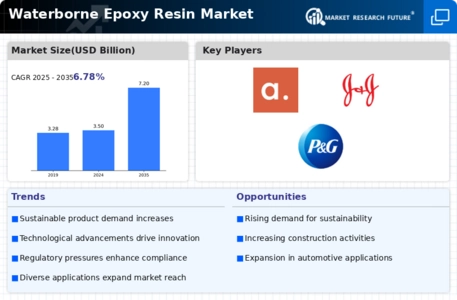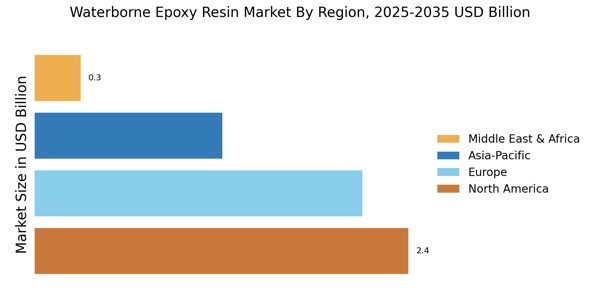Regulatory Compliance
Stringent regulations regarding VOC emissions and environmental safety are influencing the Waterborne Epoxy Resin Market. Governments worldwide are implementing policies that favor low-emission products, prompting manufacturers to shift towards waterborne formulations. In 2025, compliance with these regulations is expected to drive the adoption of waterborne epoxy resins, as they meet the required standards for safety and environmental impact. This regulatory landscape creates a favorable environment for the Waterborne Epoxy Resin Market, as companies that adapt to these changes can gain a competitive edge. The focus on compliance not only enhances product credibility but also aligns with the growing consumer demand for sustainable and safe materials.
Technological Innovations
Technological advancements in resin formulation and application techniques are driving the Waterborne Epoxy Resin Market forward. Innovations such as improved curing processes and enhanced performance characteristics are making waterborne epoxy resins more appealing to manufacturers. In 2025, advancements in nanotechnology and polymer science are expected to yield resins with superior adhesion, chemical resistance, and durability. These innovations not only improve product performance but also expand the range of applications for waterborne epoxy resins. As manufacturers invest in research and development, the Waterborne Epoxy Resin Market is likely to experience a surge in new product offerings, catering to evolving consumer demands and industry standards.
Sustainability Initiatives
The increasing emphasis on sustainability appears to be a pivotal driver for the Waterborne Epoxy Resin Market. As industries strive to reduce their environmental footprint, waterborne epoxy resins, which are low in volatile organic compounds (VOCs), are gaining traction. This shift aligns with regulatory frameworks that advocate for eco-friendly materials. In 2025, the demand for sustainable coatings is projected to grow, with waterborne epoxy resins expected to capture a significant share due to their reduced environmental impact. Companies are increasingly adopting these resins to meet consumer preferences for greener products, thereby enhancing their market position. The Waterborne Epoxy Resin Market is likely to benefit from this trend as manufacturers innovate to create formulations that are both effective and environmentally responsible.
Growing Construction Sector
The expansion of the construction sector is a significant driver for the Waterborne Epoxy Resin Market. As urbanization continues to rise, the demand for construction materials, including coatings and adhesives, is increasing. In 2025, the construction industry is projected to witness substantial growth, particularly in emerging markets where infrastructure development is a priority. Waterborne epoxy resins are favored for their durability and low environmental impact, making them ideal for various applications in construction. This trend suggests that the Waterborne Epoxy Resin Market is poised for growth, as manufacturers align their offerings with the needs of a booming construction sector, potentially leading to increased sales and market share.
Diverse Industrial Applications
The versatility of waterborne epoxy resins is a notable driver for the Waterborne Epoxy Resin Market. These resins find applications across various sectors, including automotive, construction, and electronics. In 2025, the construction industry is anticipated to be a major consumer, utilizing waterborne epoxy resins for flooring, coatings, and adhesives. The automotive sector is also increasingly adopting these materials for their lightweight and durable properties. This broad applicability suggests that the Waterborne Epoxy Resin Market is well-positioned for growth, as manufacturers continue to explore new uses and formulations. The ability to cater to diverse industrial needs enhances the attractiveness of waterborne epoxy resins, potentially leading to increased market penetration.


















Leave a Comment